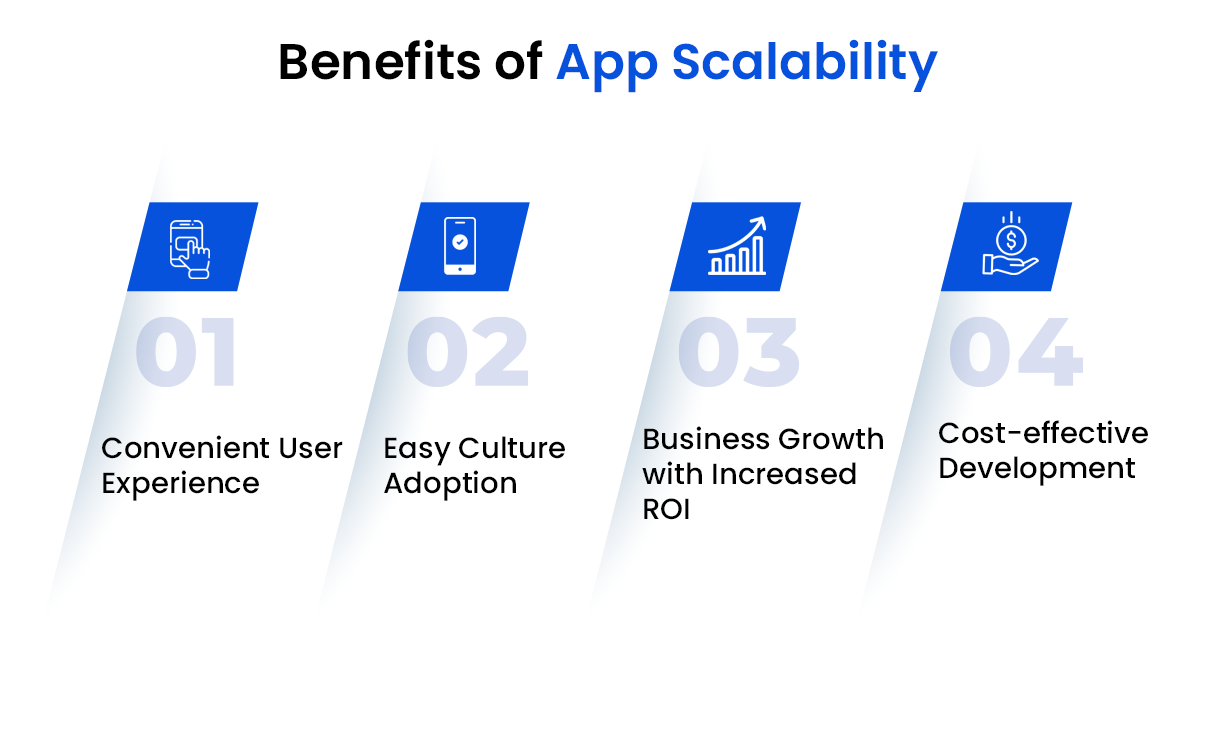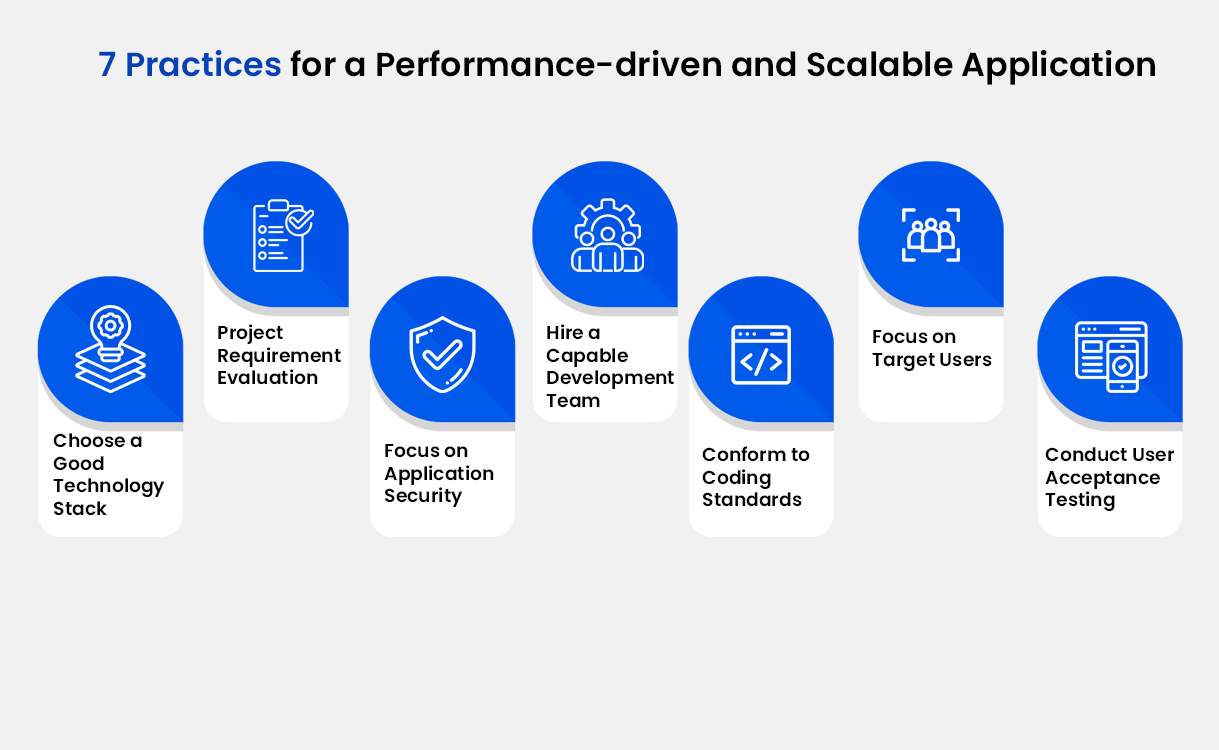
7 Tested Practices to Build a Scalable Mobile App
- By Zachary Davies
- 14-03-2023
- Mobile App Development
Building scalable applications is a beneficial approach that can ensure lasting growth for your mobile app business. An app that can store/process large data and function effectively for a wide user base always proves more user-friendly for customers. Building such high-leveled scalable architecture primarily requires a secure and expandable database powered by cloud computing. Therefore, the cloud computing system global market had a value of $140 billion in 2021 and is estimated to reach $168.6 billion by 2025.
Every mobile application must be able to handle more load and changing demand of the user base as and when required, and focusing on expandable scalability in the mobile app development process is the way to do that. It can save an application from poor performance, bad user experience, unreliable data security, and downtime.
The goal of scalable applications is to improve the performance and user experience of your mobile app, the two most important qualities that determine user acquisition - retention, and defections. That is why it will be in your best interest to learn about application scalability and practices that can help you build high-performance and scalable mobile applications.
What is Scalability in Mobile App Development?
Scalability in mobile app development is the incorporation of a system that improves the flexibility of your application in data storage and processing, allowing it to handle an increasing user base with ease while providing them with an unmatched user-friendly experience. In short, it gives your application the support it can need to handle more load as required, preventing crashes and poor performance.
A scalable architecture can withstand increased traffic and load on its server without damaging the performance and user experience. It is the starting point of two different paths leading toward user retention and app installations. For example, the Android app uninstallation rate in the USA is 36.4% after 30 days of installation. While factors like poor-quality products/services and multiple competitors can cause such an uninstall rate, the lack of scalability is among the primary causes as it is responsible for stable application performance and convenient user experience.
Therefore, knowing which factors directly affect the scalability of your mobile app is valuable information. It can help your business build a platform where it can grow by meeting the changing functional requirements as and when required.
Application Architecture
Application architecture in scalability is the technology/framework you use to build the mobile application. Since both frontend and backend determine the scalability of your application, which technological framework you choose for app development can significantly impact the scalability of your application.
Hardware
While as an app business owner, you do not have control over the performance of the hardware of the devices you build. The different processors, cameras, microphones, speakers, touch screens, and screen sizes of mobile devices can also impact the scalability of a mobile application. To ensure your app can perform effectively on multiple devices, you must optimize its scalability and test its performance.
Third-party APIs and Libraries
A third-party library allows developers to build the application with reusable software components, reducing development costs and time. These libraries can affect the scalability based on which ones you use. Some libraries are also known for compromising the security of applications, which can lead to poor performance and user experience.
Third-party APIs are innovative technologies that improve the functional capabilities of your application. For example, A healthcare app that includes appointment scheduling and information about hospitals/clinics can be helpful. However, it can be more innovative and beneficial if it allows users (doctors and patients) to socialize/chat with other users, use cloud storage, and file-sharing functionalities.
Incorporating such elements into your app requires the use of the right APIs. They can significantly improve its scalability and performance.
App Loading Time Tests
How you test the loading time of your application is another crucial factor that determines the scalability of your application. It is because the loading time for 2000 users at once can differ from the loading time of 1000 users. Only with frequent and effective app loading testing can you improve the loading time, and thus, the scalability of your application.
Benefits of App Scalability

Application scalability has both functional and organizational benefits for your mobile app business. Its goal is to increase business growth by improving the satisfactory experience of your app for users.
- Convenient User Experience
- Easy Culture Adoption
- Business Growth with Increased ROI
- Cost-effective Development
Convenient User Experience
Scaling your application is the best way to improve user experience as it ensures stable and high performance while you incorporate new updates, innovative features, and additional products/services into the application. Since user experience is the primary deciding factor in user retention and customer defections, scaling your application for improving user experience will be the right approach for long-term success.
Easy Culture Adoption
Incorporating the cultures of your target user base in the app can increase the load during occasions like Christmas, Hanukkah, and the Day of the Dead (Día de los Muertos). It is because you have to make changes to the design, provide more features for availing offers and discounts, and include personalized products/services for those occasions. Scalability can ensure your app runs smoothly during such performance requirements.
Business Growth with Increased ROI
Scalability allows you to incorporate new updates, functionalities, UI/UX design changes, and advanced features with ease, which can significantly improve the performance of apps. It provides an innovative and satisfactory user experience for your customers. Satisfied users lead to a better return on investment (ROI) and allow you to increase/improve your business growth.
Cost-effective Development
Scaling your mobile application helps you build a basic/MVP application and create room for growth and improvement according to the new or changing demands of the user base. It allows you to save costs on development which you can use to gather and evaluate customer feedback, and improve the application as and when required. Such a process is only possible by planning and incorporating application scalability from the early stages.
7 Mobile App Development Best Practices for a Performance-driven Application
While every project requires a customized approach in development, below mentioned are some practices you can use to build high-performance and scalable applications.

7 Practices for a Performance-driven and Scalable Application
- Choose a Good Technology Stack
- Project Requirement Evaluation
- Focus on Application Security
- Hire a Capable Development Team
- Conform to Coding Standards
- Focus on Target Users
- Conduct User Acceptance Testing
Choose a Good Technology Stack
Utilize a top-tier technology stack that is feasible and most lucrative for your organization. The technology stack can include Xcode, Swift, Python, Kotlin, Java, Objective-C, React Native, MySQL, PostgreSQL, Amazon Web Services DynamoDB, and MongoDB. You must keep two things in mind when choosing a technology stack for better scalability - Programming Language and Database.
Programming Language
A programming language (Swift, Python, Kotlin, Java) is a language developers can use to read and write a codebase for a mobile application and incorporate specific functions according to project requirements. Choosing the right programming language is essential for building a high-performance and scalable application.
Database
The database of an application is a data management system that allows your app to transfer, process, and store data according to application system requirements. It is the most important element in application scalability. For example, if the programming language is a skill of professional athletes, the database would be their physical capabilities. They can improve and modify their skills only if their physical capabilities allow them to do so.
Similarly, you can only improve scalability with programming languages if the database of the application can support it.
Project Requirement Evaluation
You must analyze application requirements, available resources, project goals, and budget before the development begins. It will allow you to create a customized development plan that can ensure your app has high performance and scalability. Project requirement analysis is necessary to avoid the incorporation of ineffective strategy, which can lead to an average-performance app and bad scalability. It allows you to ensure a lucrative outcome by simplifying the effective use of all the available resources.
Focus on Application Security
Application scalability is all about meeting the changing user needs and the durability of a system required for an increasing user base and high traffic. And app security, mainly user privacy and data security are the two most crucial qualities that users today value in mobile applications. Therefore, implementing the best security protocols and meeting all the necessary security standards is crucial to meet such scalability requirements.
While there is no guaranteed way to ensure secure mobile app development, you can use multiple solutions, test them frequently, and improve them to ensure your app is secure for target users.
Hire a Capable Development Team
You must ensure your development team is skilled and experienced enough to build a performance-driven scalable application. Choosing an unsuitable team can leave you with an app with a bad user experience and poor scalability. The best way to approach this is by hiring a self-sufficient and Agile-driven development team. Such a team can help plan, test, and manage the scalability of your application.
The most cost-effective way to find such a team is by outsourcing to offshore developers from India or Ukraine. Developers from these countries have a global understanding of application scaling and performance, and they provide development solutions at much lower or affordable costs than developers from countries like the US or UK.
Conform to Coding Standards
Conforming to coding standards and guidelines will make your application code easy to write, read, and modify. Such an app development process will simplify the incorporation of scalability in your application. It allows you to build a high-performance mobile application that can outperform the competition. Quality-driven coding process also helps improve the scalable capabilities of your application from the early stages of app development.
Focus on Target Users
Who will be using your mobile app? What are their demands and needs? How often do their needs change? What qualities will it take to satisfy their needs with your app? Evaluating the target users is the best way to build a high-performance and scalable application. It is because the requirements of a target user base can vary and knowing what they are can help you personalize the high-performance and scalable qualities of your application.
You can conduct market research with multiple surveys to gather and analyze information such as demographics, interests and needs, and online buying behavior. It will help you formulate a strategic plan for building a scalable high-performance application.
Conduct User Acceptance Testing
User acceptance testing is an application testing approach involving target users in the testing process to conduct the process from an end-user perspective. While creating a user-driven app development process helps you personalize its scalability and performance, UAT helps test whether it meets all the requirements of the target user base. It allows you to identify the weak and strong points of your and ensure it meets all quality standards before approving it for deployment.
Such a process is necessary to avoid app installation and customer defections. For example, 70% of smartphone users switch to another app if the application they are using takes too long to load. Such a flaw becomes easy to identify and deal with when you test the application from the perspective of end users.
The feedback you receive from user acceptance can help you significantly improve the personalized scalability and high performance (user experience) of your app, ensuring better user acquisition and retention before the deployment.
Conclusion
The most crucial thing you must focus on for building performance-driven and scalable applications is the user base. It is because the user base of various applications has different needs and interests. For example, the users of an e-learning app (students/learners) do not necessarily have the same lifestyle, interests, or needs as the target users of a healthcare application. Therefore, every target user base has different scalability and performance requirements in an application.
Once you know the requirements of your target users, you can create a better development focused on performance and scalability that can satisfy their needs. While technology, development team, and coding standards are all secondary elements, the target user base is the primary element that can help you achieve business goals. It will allow you to understand project requirements and a necessary development approach for a user-driven, scalable, and high-performance mobile application.
Recent blog

Harnessing Social Media: Tactics For Powerful Marketing Success Achievement
Social Media | 25-07-2024
7 Hidden Secrets of MSI Laptop Boot Menu Key
Technology | 24-07-2024




